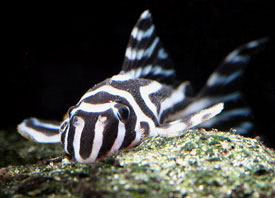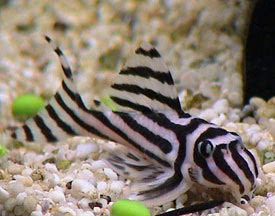
 Magyarul / Hungarian
Magyarul / Hungarian


- Scientific name: Hypancistrus zebra
- Synonyms: L-46 catfish
- Common name: Zebra pleco
- Group: Catfishes
- Habitat: South America; On rocky substrates of the Rio Xingu (Brasil)
- Size: 10 cm
- Biotope: fast-moving rivers
- Social behavior: A small, shy fish that should not be combined with other bottom dwellers that will compete for food. Each fish sets up a small territory around a selected retreat. In a good sized tank (25 gallons or more), a number of Zebra Plecos can be kept as long as each is supplied with a retreat. Keep with small, peaceful fish of the upper swimming levels. A nocturnal fish.
- Diet: Live, Brine Shrimp, insect larvae, Daphnia, Cyclops, vegetables, lettuce, spinach, zucchini, tablets, flake
- Breeding: Quite easy, but rare.
- Tank: Minimum 200 litres
- Population: 1 couple for 200 litres
- Decoration: Provide a hiding places for each fish with rocks having crevices, holes, and caves. Driftwood can be added, though it is not a requirement as Zebras do not chew on the wood like other Loricarids. The tank should be well-planted and well oxygenated, as its native waters are oxygen-rich.
- Temperature: 25-28°C
- pH: 7-7,5.
- Hardness: 5,6-14 NK°
- Lifespan: 10 years
Description: Similar in body shape to Peckoltia species. The body is bright white in color with an overlaying, unique pattern of black stripes. This pattern continues through the fins. No two specimen are said to have the same pattern.
There are at least four factors important in stimulating spawning of the Zebra Pleco: an increase in water temperature to 82-86°F (28-30°C), a high oxygen content of the water, a moderate to strong water current and suitable breeding caves. The spawning caves should be just long enough to house a fish and wide enough for two Zebra Plecos and should have some water current passing through it. Spawning is most likely in a tank with several Zebra Plecos and numerous spawning caves. Fish may pair off and lay cloudy-white eggs within a cave. The male chases out the female and guards the eggs, which usually number 8-15. He will continue to guard the fry until they can feed on their own. The eggs can be removed and reared artificially in a well-aerated rearing tank. The eggs hatch six days after being laid and the fry can be first fed two weeks after hatching (when their egg sacs are depleted). Start feeding with Brine Shrimp nauplii and dry foods. Make frequent partial water changes on the rearing tank. The young grow slowly, but can reach 1" (2.5 cm) in under 3 months.




















